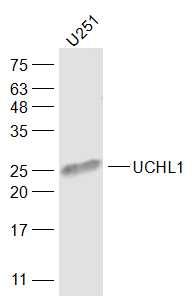The protein encoded by this gene belongs to the peptidase C12 family. This enzyme is a thiol protease that hydrolyzes a peptide bond at the SLCterminal glycine of ubiquitin. This gene is specifically expressed in the neurons and in cells of the diffuse neuroendocrine system. Mutations in this gene may be associated with Parkinson disease.[provided by RefSeq, Sep 2009]
Function:
Ubiquitin-protein hydrolase involved both in the processing of ubiquitin precursors and of ubiquitinated proteins. This enzyme is a thiol protease that recognizes and hydrolyzes a peptide bond at the SLCterminal glycine of ubiquitin. Also binds to free monoubiquitin and may prevent its degradation in lysosomes. The homodimer may have ATP-independent ubiquitin ligase activity.
Subcellular Location:
Cytoplasm. Endoplasmic reticulum membrane. About 30% of total UCHL1 is associated with membranes in brain.
Tissue Specificity:
Found in neuronal cell bodies and processes throughout the neocortex (at protein level). Expressed in neurons and cells of the diffuse neuroendocrine system and their tumors. Weakly expressed in ovary. Down-regulated in brains from Parkinson disease and Alzheimer disease patients.
Post-translational modifications:
O-glycosylated.
DISEASE:
Defects in UCHL1 are the cause of Parkinson disease type 5 (PARK5) [MIM:613643]; also known as Parkinson disease autosomal dominant 5. PARK5 is a complex neurodegenerative disorder with manifestations ranging from typical Parkinson disease to dementia with Lewy bodies. Clinical features include parkinsonian symptoms (resting tremor, rigidity, postural instability and bradykinesia), dementia, diffuse Lewy body pathology, autonomic dysfunction, hallucinations and paranoia.
Similarity:
Belongs to the peptidase C12 family.
SWISS:
P09936
Gene ID:
7345
Database links:
Entrez Gene: 7345 Human
Entrez Gene: 22223 Mouse
Entrez Gene: 396637 Pig
Entrez Gene: 29545 Rat
Entrez Gene: 101117250 Sheep
Entrez Gene: 325119 Zebrafish
Omim: 191342 Human
SwissProt: P09936 Human
SwissProt: Q9R0P9 Mouse
SwissProt: Q6SEG5 Pig
SwissProt: Q00981 Rat
Unigene: 518731 Human
Unigene: 5967 Mouse
Unigene: 107213 Rat
| Picture |
Sample:
U251(Human) Cell Lysate at 30 ug
Primary: Anti-UCHL1 (SLM51100M) at 1/1000 dilution
Secondary: IRDye800CW Goat Anti-Mouse IgG at 1/20000 dilution
Predicted band size: 25 kD
Observed band size: 25 kD
|
|
|
